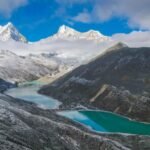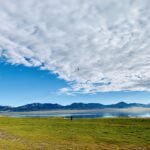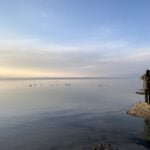Sechen Lhatso is known to the local people as the Holy lake where the God of fortune (King of Naga) lives. It is located in the southeast of Riduo Township, Maldrogongka County, and north of Sangri County, Shannan Region. It is about 6 km from National Highway 318, and 124 km from Lhasa City, at an altitude of 4500 meters.
According to the Tibetan ancient book “Five Relics” and other Tibetan records, Maldro Sechen Lhatso Lake is like a treasured plate with gold and silver to surround the Mandala. The blue sky reflected in the lake. The fortune god (King of Naga) sprinkled the treasure on the earth, sprinkled the whole snow mountains and rivers, and decorated it with a variety of precious herbs and trees, flowers, and wild animals.
Views nearby Sechen Lhatso Lake
The mountain behind the Sechen Lhatso lake is shaped like a turtle King. There has a meditation cave of Guru Rinpoche and his disciples.
There are sixteen Arhats standing on the mountains to the east of holy Lake, on the southeast side you can also see the famous snow peak mountain. It is said that worshiping this sacred mountain can not only accumulate good fortune but also health and longevity. The southern mountain range of the lake is dedicated to the mandala, and the western mountain range is the throne on the back of the elephant.
It is surrounded by small lakes, each of which has a different symbolic meaning and historical origin, as well as the legend. In the east there are five small lakes symbolizing the five flying angel, in the south, there are six lakes symbolizing the six world, in the west, there are eight small lakes symbolizing the eight incarnations of Padmasambhava. in the north, there are three small lakes symbolizing the “three precious”.
Legends of Lake Sechen Lhatso
Legend has it that when King Trisong Deutsen built the Sangye Temple, he was worried that there was no gold to give the Buddhas, and the Guru Rinpoche came up with an idea for Tibetan king that finds the richest individual in the world, Lū Maldro Sechen (Naga King). From him, the king can get gold. When King Trisong Deutsen had just reached the black lake. A fierce viper came out of the lake and blocked the king’s way. At that moment, Guru Rinpoche cast a spell from the cave to subdue the Demon viper and throw the cut-off tongue into the lake. It later turned into the snake tongue lawn.
Next to the snake tongue lawn, there is a cushion-shaped green lawn along the lake, which was made by Guru Rinpoche for King Trisong Deutsen. The king sat on the lake and send a message to the Naga king. He dropped more than 7,000 gold coins on King’s hand. King Trisong Deutsen was happy and burned incense and worshiped the Naga King, as a token of gratitude. Samye monastery has a history of thousands of years but still continues to burn incense and worship Lū Maldro Sechen, the naga King as custom.
Every year, on the 15th of June, the Panchen Lama and Masters from Drikung come to the lake to pay their respects. and many gold and silver treasures are poured into the lake in return for the gifts of the Lake. This custom slowly formed a system. There are many historical relics of the welcome throne and Temple on the shore of Lake Sechen Lhatso, and a beautiful lawn where tents are built.
When there was a very dry season in Tibet. Monks from Rithok Temple and Drikung-til will go to the lake and praying for rain.


















